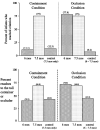Décalage in infants' knowledge about occlusion and containment events: converging evidence from action tasks
- PMID: 15939414
- PMCID: PMC1542069
- DOI: 10.1016/j.cognition.2005.01.010
Décalage in infants' knowledge about occlusion and containment events: converging evidence from action tasks
Abstract
In the present research, 6-month-old infants consistently searched for a tall toy behind a tall as opposed to a short occluder. However, when the same toy was hidden inside a tall or a short container, only older, 7.5-month-old infants searched for the tall toy inside the tall container. These and control results (1) confirm previous violation-of-expectation (VOE) findings of a décalage in infants' reasoning about height information in occlusion and containment events; (2) cast doubt on the suggestion that VOE tasks overestimate infants' cognitive abilities; and (3) support recent proposals that infants use their physical knowledge to guide their actions when task demands do not overwhelm their limited processing resources.
Figures


Similar articles
-
Young infants' actions reveal their developing knowledge of support variables: converging evidence for violation-of-expectation findings.Cognition. 2008 Apr;107(1):304-16. doi: 10.1016/j.cognition.2007.07.009. Epub 2007 Sep 7. Cognition. 2008. PMID: 17825814 Free PMC article.
-
Detecting continuity violations in infancy: a new account and new evidence from covering and tube events.Cognition. 2005 Mar;95(2):129-73. doi: 10.1016/j.cognition.2002.11.001. Cognition. 2005. PMID: 15694644 Free PMC article.
-
Young infants' reasoning about hidden objects: evidence from violation-of-expectation tasks with test trials only.Cognition. 2004 Oct;93(3):167-98. doi: 10.1016/j.cognition.2003.09.012. Cognition. 2004. PMID: 15178376 Free PMC article. Clinical Trial.
-
The developmental origins of naïve psychology in infancy.Adv Child Dev Behav. 2009;37:55-104. doi: 10.1016/s0065-2407(09)03702-1. Adv Child Dev Behav. 2009. PMID: 19673160 Review.
-
Infants' reasoning about hidden objects: evidence for event-general and event-specific expectations.Dev Sci. 2004 Sep;7(4):391-414. doi: 10.1111/j.1467-7687.2004.00357.x. Dev Sci. 2004. PMID: 15484586 Free PMC article. Review.
Cited by
-
Can infants be "taught" to attend to a new physical variable in an event category? The case of height in covering events.Cogn Psychol. 2008 Jun;56(4):284-326. doi: 10.1016/j.cogpsych.2007.06.003. Epub 2008 Jan 3. Cogn Psychol. 2008. PMID: 18177635 Free PMC article. Clinical Trial.
-
Object Individuation and Physical Reasoning in Infancy: An Integrative Account.Lang Learn Dev. 2012 Jan;8(1):4-46. doi: 10.1080/15475441.2012.630610. Epub 2012 Jan 12. Lang Learn Dev. 2012. PMID: 23204946 Free PMC article.
-
Infants can use temporary or scant categorical information to individuate objects.Cogn Psychol. 2024 Mar;149:101640. doi: 10.1016/j.cogpsych.2024.101640. Epub 2024 Feb 26. Cogn Psychol. 2024. PMID: 38412626 Free PMC article.
-
Young infants' actions reveal their developing knowledge of support variables: converging evidence for violation-of-expectation findings.Cognition. 2008 Apr;107(1):304-16. doi: 10.1016/j.cognition.2007.07.009. Epub 2007 Sep 7. Cognition. 2008. PMID: 17825814 Free PMC article.
-
When the ordinary seems unexpected: evidence for incremental physical knowledge in young infants.Cognition. 2005 Apr;95(3):297-328. doi: 10.1016/j.cognition.2004.01.010. Epub 2005 Jan 7. Cognition. 2005. PMID: 15788161 Free PMC article.
References
-
- Aguiar A, Baillargeon R. Perseveration and problem solving in infancy. In: Reese HW, editor. Advances in child development and behavior. Vol. 27. Academic Press; San Diego, CA: 2000. pp. 135–180. - PubMed
-
- Baillargeon R. The object concept revisited: New directions in the investigation of infants' physical knowledge. In: Granrud CE, editor. Visual perception and cognition in infacncy. Erlbaum; Hillsdale, NJ: 1993. pp. 265–315.
-
- Baillargeon R. The acquisition of physical knowledge in infancy: A summary in eight lessons. In: Goswami U, editor. Blackwell handbook of childhood cognitive development. Blackwell; Oxford: 2002. pp. 46–83.
-
- Baillargeon R, DeVos J. Object permanence in 3.5- and 4.5-month-old infants: Further evidence. Child Development. 1991;62:1227–1246. - PubMed
Publication types
MeSH terms
Grants and funding
LinkOut - more resources
Full Text Sources
Miscellaneous

